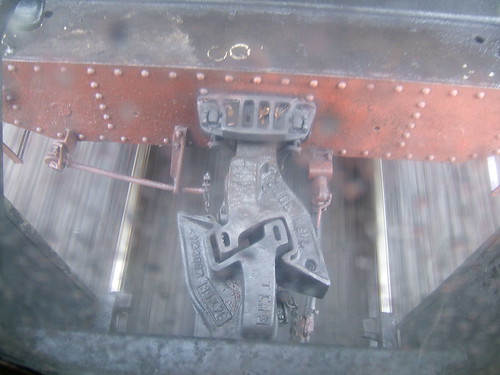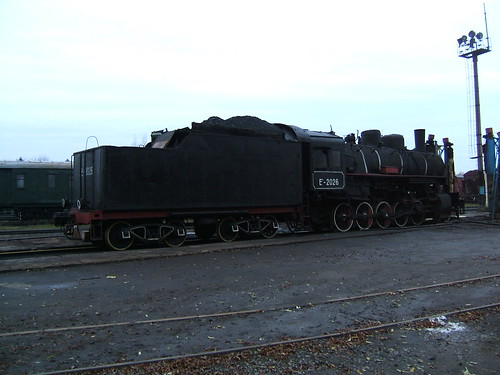One group were allocated to Er797-86 which, with bogie wagons as a load, was heading south-west on the Rakhov line.
The second group were allocated to Su251-86 which, with a similar load, was heading south-east for Chernivtsi.
My friend Mike and I, with two others, were with Em735-72, with one of the coaches and two bogie wagons which would head north-east to Stefaneshty.
Railways around Kolomiya.
Of course, each locomotive was under the control of a Ukrainian Driver and Fireman. Since few railwaymen in Ukraine have much English, the problem of communication had been addressed by Dzherelo SPK by providing a bilingual college student on each locomotive to act as an interpreter. The idea was that two of each group would be Trainee Driver and Fireman for a time before swopping roles. The two Engineer's coaches which Su251-86 had arrived with were allocated to two of the trains to provide accommodation for the other two trainees who would exchange with the pair on the footplate at a suitable stopping point.
After the first day, I think the whole group stayed on the footplate and swopped round as necessary. The Russian loading gauge is particularly generous and the cabs were large so this presented no problem. I was reminded of my first time on the footplate of a Broad Gauge steam locomotive in India in 1992 (described here), when I commented at the time that the cab was big enough "to hold a party".
 Em 735-72 in the sidings ready to leave Kolomiya.
Em 735-72 in the sidings ready to leave Kolomiya.
We set off, passed the roundhouse and the diesel shed, taking the left of two single lines, with the line to Chernivtsi on our right. The map above shows how sinuous the line to Stefaneshty is, as it winds through rolling hills. The line is something of a switchback too so, having set the regulator and cut-off to the Ukraine Driver's instructions, speed would fall a little on the uphill sections, then pick-up again on the downgrades. I was driving at this point and, although the locomotive might have been a rather battered survivor, I had the confidence that it would just keep clomping along for ever. And, of course, I would have stayed in the right-hand driver's seat for ever but we had three other trainees to share with. All too soon, we were arriving at Stefaneshty. The single line from Luzhany (on the direct line from Kolomiya to Chernivtsi) converged on our right and we were routed into the rightmost loop line, where we stopped opposite the station building. With our winding route from Kolomiya, we must have travelled around 80 km.
 Em 735-72 on arrival at Stefaneshty.
Em 735-72 on arrival at Stefaneshty.
The Ukrainian Fireman immediately set-to emptying ash from the ashpan, whilst his driver oiled round the motion again. I don't know whether the ashpan had been emptied the previous evening, but there was certainly plenty of ash dumped between the rails at Stefaneshty. The fireman detached the locomotive from its train (one air brake hose to disconnect, then pull the release lever to open the knuckle on the massive Russian-pattern automatic coupler) and the Ukrainian Driver ran the locomotive around its train.
 Em 735-72: Oiling round and Ashing-out at Stefaneshty.
Em 735-72: Oiling round and Ashing-out at Stefaneshty.
We set off in the opposite direction, this time with Em 735-72 running tender-first. At the south end of Stefaneshty, we were routed onto the left-hand single line to Luzhany, leaving the line we'd travelled earlier on our right. A journey of about 35 km took us to the junction at Luzhany where, once again, Em 735-72 was run around its train. The engine was now chimney-leading again, for the last leg of about 60 km back to Kolomiya. I know that Mike and I travelled in the coach for at least part of this journey, because I was able to take a picture of the standard Russian Autocoupler.
 Em 735-72 at speed in the rain, showing Russian pattern autocoupler between tender & coach. The release lever to open the knuckle on the coupler is on the left and the air brake hose (with two red-painted 'palm' couplings between the vehicles) is just to the right of the Automatic Coupler.
Em 735-72 at speed in the rain, showing Russian pattern autocoupler between tender & coach. The release lever to open the knuckle on the coupler is on the left and the air brake hose (with two red-painted 'palm' couplings between the vehicles) is just to the right of the Automatic Coupler.
We arrived back at Kolomiya safely, as did Su251-86 returning from Chernivtsi. But we learnt that Er797-86 had got into trouble on the Rakhov line, short of steam, causing some disruption to the public trains and resulting in a late arrival back in Kolomiya. Further disappointing news was that, since YeA 2026 had failed another steam test, there was insufficient time to cool the boiler down, carry out remedial work, light it up again and carry out a further steam test before the end of our visit. With great regret, YeA 2026 was 'scratched'.
 YeA 2026 left to cool-down after failing the steam test.
YeA 2026 left to cool-down after failing the steam test.
We returned to our hotel for an evening meal and bed, because we had another early start the following day when we'd do it again.
Continued in Driving Steam in Ukraine (Part 3).
Russian Railway background
At the time of my visit to Ukraine in 2005, I was almost completely ignorant about Russian Railway practice. The book 'Soviet Locomotive Types - The Union Legacy' (reference [1] below) is an invaluable primer on Russian steam, diesel and electric traction. In 2011, a river cruise from Moscow to St. Petersburg (described in a series of posts here) gave me tantalising glimpses of railways in Russia. Then, in 2011, I travelled by the 'Golden Eagle' private train from Ulaan Baatar to Moscow (described in a series of posts here).
Book References
[1] 'Soviet Locomotive Types - The Union Legacy' by A J Heywood & I D C Button (Frank Stenvalls Forlag) ISBN 0-9525202-0-6.
My Pictures
Ukraine Steam.
